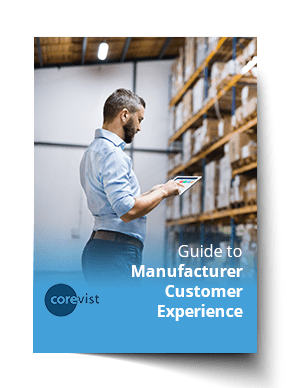Share
Author
George Anderson
Share
A recent article from McKinsey & Co. offered great insight for industrial manufacturers looking to digitize their customer experience. One quote really stood out to us.
“Too often, industrials push for digital solutions because they see their competitors launching initiatives and they fear missing out. In their haste, they may launch ambitious campaigns without appreciating the enormous resources — time, money, staff — required.”
We’ve seen this too many times with manufacturers launching B2B portals and eCommerce. Since digital initiatives are new territory for many manufacturers, it’s hard to know where to start, and the true needs of customers may not be obvious.
Here are four questions you can ask to determine the highest priorities for your first (or next) round of digital transformation.
1. What’s the biggest pain point in your customer experience today?
When manufacturers look at digitizing customer experience, it’s easy to bite off more than you can chew. We’ve seen this with gigantic B2B eCommerce projects that require a custom integration to SAP ERP, which never gets off the ground. (This is why all Corevist solutions include prebuilt SAP integration, by the way.) The heavy lifting was simply too heavy, and the organization ends up spending millions of dollars on a half-baked solution that doesn’t actually serve customers’ needs.
While you may have many pain points in your customer experience, it’s helpful to isolate one to three that are most problematic. McKinsey’s article points us in the right direction here: “Digital tools can also help companies standardize lead times and make them more transparent; this will improve customer experience, since a lack of visibility into order tracking is a common pain point in the industrial sector.”
Here are the most common pain points we see when manufacturers come to us.
- Customers have to call or send an email to get order tracking information. This was always a problem, but supply chain disruption due to COVID-19 made it much worse. Even in late 2021, those supply chain disruptions are only growing worse.
- Customers have to call or send an email to get product availability. Most likely, your SAP ERP system is configured to generate available RDDs (requested delivery dates) for a product based on factors ranging from supply chain status to demand. With economic disruption pushing product availability dates farther out, customers are experiencing plenty of doubt and uncertainty. That means more inquiries to customer service as delays occur. This information lives in SAP in real time, but customers can only access it through a representative.
- Customers would like to order online, but the B2B portal or eCommerce store doesn’t show the right pricing (or real-time availability). These are serious issues that have stopped many B2B eCommerce programs in their tracks. The culprit is always a lack of real-time SAP ERP integration.
Ideally, you’ll want to solve these problems in the same solution. But it’s not always wise to solve them all at once. In particular, many manufacturers start with a solution like Corevist Order Tracking, which solves the customer self-service problem, then scale up to Corevist Commerce to add online catalogs and ordering with personalization driven by SAP business rules.
Whether you’re pursuing a multi-phase, iterative transformation, or just solving one pain point, it’s good to start by analyzing the largest pain point.
NEW Resource:
Ultimate Guide to Manufacturer Customer Experience
Use these 5 keys to create a competitive customer experience in the digital age.
2. What would it take to solve your biggest pain point?
This exercise keeps organizations from biting off more than they can chew. You may eventually address all problems — or, realistically, you may have to prioritize given the resources you have.
Whatever problem is biggest in your customer experience, explore solving that problem alone. What does it look like?
We’ll take customer order tracking as an example (largely because so many manufacturers start there with Corevist). For organizations running on SAP ERP, here’s what it takes to give customers self-service tracking capabilities.
- You’ll need a customer portal solution that includes prebuilt, real-time integration to SAP. If the integration isn’t prebuilt, you’ll waste resources reinventing the wheel. If it doesn’t work in real time, it won’t provide essential elements of customer experience like accurate credit status, shipment status or product availability.
- SAP needs to reflect the right order and account history data for every customer who will use the portal. In the vast majority of cases, the IT organization has already set up SAP to support this. However, if your SAP system needs help in this area, a partner like Corevist can advise on standard configurations that work flawlessly with our prebuilt SAP integration.
- You should choose a managed, cloud-hosted SaaS platform so your solution is always secure and up-to-date. If you don’t go the managed SaaS route, you’ll need a partner or the internal resources to support and upgrade your B2B portal.
- Your B2B portal needs to integrate with major carriers so customers can see real-time shipment status and tracking. Note that Corevist solutions provide this out of the box.
3. Do we have the internal resources to execute this?
By now, you can see what’s required to improve customer experience for manufacturers. You need a scalable B2B portal solution that can cover the entire buying journey (browsing, purchasing, tracking, and paying). And that portal needs comprehensive, real-time SAP integration.
Here’s where many manufacturers stumble.
It’s rare for organizations to have the talent and resources to launch (and support) a B2B portal with deep SAP integration. We’ve seen too many manufacturers who’ve chosen a standalone B2B eCommerce platform, saved SAP integration for the end of the project, and watched as it never materialized.
For organizations with limited IT resources, it’s often wiser to choose a managed B2B portal solution that includes SAP integration. With a trusted partner covering the entire technology stack, you can create a better customer experience while focusing on your core business. This is the thinking behind Corevist solutions.
4. After we solve our biggest problem, how do we iterate?
In our example scenario, what do you do after solving the customer order tracking problem?
Ideally, you’ll want to engage a B2B portal platform that allows you to expand from there. You may want to add online catalogs and ordering with customer-specific pricing and availability built in. You may want to add self-service invoice payments so customers can pay you faster (and keep their accounts in good standing).
With functionality like this in place, you may want to expand your global footprint with spinoff sites for different brands or geographies. Ideally, you should be able to do this without reinventing your SAP integration architecture every time. (Hint: Corevist’s scalable technology checks all these boxes.)
Whatever your path, the key is to work iteratively. Take one small problem in customer experience, solve it, and move on to the next problem. A phased approach like this allows you to gather crucial learning along the way — and it prevents exhaustive projects that don’t actually improve customer experience.
NEW Resource:
Ultimate Guide to Manufacturer Customer Experience
Use these 5 keys to create a competitive customer experience in the digital age.










